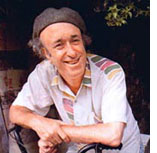By Dan Bloom

CHIAYI CITY, Taiwan –I’ve lived in a few countries overseas in my life, and one of the places that has made a big impression on me was Italy. Several things happened there that I remember to this day, even though they happened over 40 years ago.
And with Christmas Day just around the corner, in Rome and all around the world as well, this time of year brings me back down memory lane and here’s why.
I lived in Rome in the 1970s and I’ll never forget going to the Christmas Day speech by the then Pope delivered from a balcony overlooking St. Peter’s Square on a cold winter day. I have no idea what the Pope was saying, since it was all in Italian, but it was an “event,” even a “happening,” to be standing in a huge throng of people listening the the head of the Catholic Church giving his annual address.
I shivered, I listened intently and I took a few moments to embrace my Jewish heart within the Holy See, not so far away from a local neighborhood that was once the Jewish Ghetto in Rome for over 300 years from 1555 to 1870. Who knew?
Now I know and now I have also learned that Rome has a new tourist walk: A virtual stroll through the streets of the now-disappeared ghetto to which Jews were confined for more than three centuries.
Yes, believe it or not, the Jewish museum in Rome has set up a novel way to “virtually” explore what was once a jumbled, overcrowded neighborhood using an interactive table which provides access to a detailed 3-D map that works like a Google street view. Only this is the Ghetto, the notorious Ghetto, established by a Papal Bull of 1555.
The Jewish museum is part of the same building that houses Rome’s main synagogue. Museum directors are still discussing whether the 3-D vision of the ghetto will be made available worldwide online later in 2015. For now, you have to go to Rome to see the exhibit in action.
I have an amazing Rome story to tell, and I am telling it for the first time publicly here. Read on, but read what I have to say with a sense of sadness as well.
In the winter of 1971, I lived in a section of Rome called Trastevere, not far from the Vatican, and since I was still a college student living on a backpacker’s budget, I found a place to live in a small youth hostel there. One of my room-mates in the large dorm where people from a variety of nations bunked down at night was a Hungarian man by the name of Laszlo Toth. If his name does not ring a bell yet, it soon will, and if not, Google it.
Laszlo had a Ph.D in geology from a Hungarian university in Budapest and he had just spent two years in the Outback of Australia doing field work for a mining firm. In Rome, he was apparently on a rest and relazation break from his geology work.
He played the guitar, he spoke fluent English, he was a few years older than me and he semed in most resoects to be a very nice chap.
One thing stood out: He carried a Bible in Hungarian around with him all the time, and when I asked him why he had the Bible with him, he said that as a Christian he was not very religious but that he just enjoyed reading the ancient book.
We spent many pleasant days sightseeing around Rome together, visiting the American Library run by the U.S. Embassy — me to read English newspapers for news of back home, and Laszlo to sit down and study his Bible — and I enjoyed his friendship.
Then one day a few months later after returning to Boston to resume my final years at Tufts, I was shopping in a Cambridge supermarket when I noticed Laszlo’s face on the front page of the Boston Globe. The headline read: “Hungarian man takes hammer to Michelangelo’s “Pieta.'”
I was blown away, to use the jargon of the 1970s. Yes, Laszlo had come to believe that he was Jesus Christ returned to Earth and he decided, for reasons we will never know or understand, to make a name for himself by smashing the nose off the “Pieta” at the Vatican Museum. I never heard from him again, but recently I have learned that after going to prison and then to a mental hospital in Italy he returned to Australia and now in his late 70s he is currently living in a nursing home in Sydney.
Now you know the story of Laszlo Toth, my roommate in a youth hostel dormitory in Rome in the 1970s. Surely, if there is a Lord, the Lord works in mysterious ways! Laszlo was not Jesus Christ. He was just a mentally-unbalanced Hungarian man who went overboard. I’ll never forget him.
*
Bloom is a freelance writer based in Taiwan and an inveterate web surfer. Comments may be placed in the box provided below this article or sent to the author directly at dan.bloom@sdjewishworld.com
The lords humanity foundation pallet includes a variety of hues of human psychological inconsistencies. We could what if? to death those errant human frailties that some unfortunates contend with in life. They may not meet the sought after standard of “mentally sane, correct or acceptable from outward appearances, however, we can’t ever tell if we will become the next Lazlo. Some compassion, a pause and a thought would do us all well.
Joe’s rant on human kind…